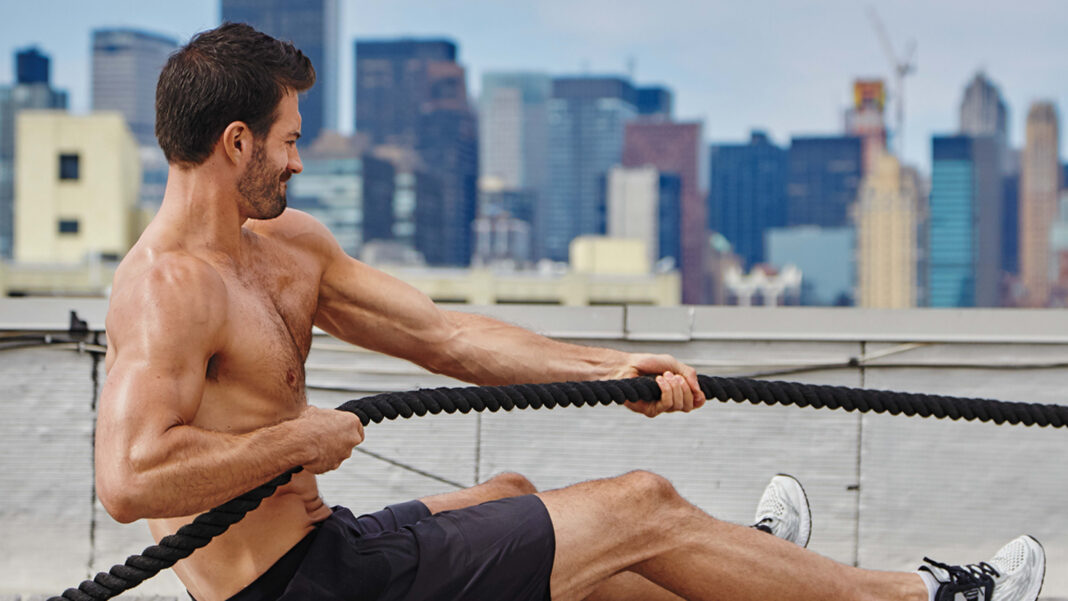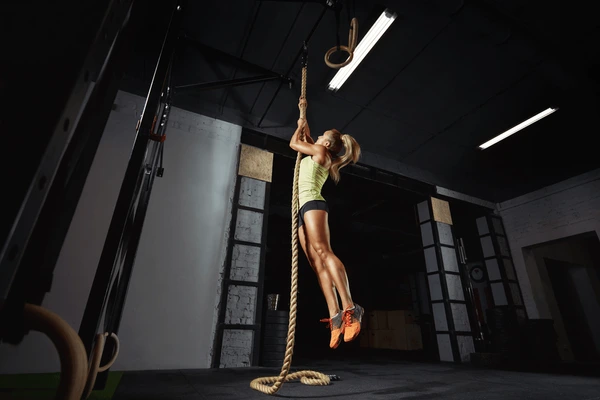Rope Pull (Seated Rope Sled Pull for Grip and Forearm Strength)
The Controlled, Muscle-Building Alternative to Rope Climbing
When it comes to building serious forearm density, grip strength, and pulling power, few exercises can rival the rope pull. Imagine combining the raw forearm demand of a rope climb with the stability and control of a seated position — that’s exactly what the seated rope sled pull delivers.
This exercise is a functional powerhouse that targets the forearms, biceps, and upper back, while also building explosive pulling strength and grip endurance.
Unlike traditional curls or wrist exercises, rope pulls develop your ability to generate tension through a long range of motion, while keeping the forearms under constant isometric stress.
It’s a movement that bridges the gap between bodybuilding, strongman, and athletic training — making it equally valuable for physique development and real-world performance.
Whether you’re looking to build meaty, veiny forearms, increase your deadlift lockout strength, or enhance your functional pulling ability, this exercise belongs in your arsenal.
Muscles Worked
Primary Muscles:
- Forearm Flexors – maintain the rope grip through dynamic tension.
- Brachioradialis – key driver of forearm strength during pulling.
- Biceps Brachii & Brachialis – assist in each rope pull motion.
- Wrist Flexors & Finger Flexors – responsible for clamping and holding the rope.
Secondary Muscles:
- Lats & Rhomboids – stabilize the shoulder girdle and assist in pulling the sled.
- Rear Deltoids – help extend the shoulder.
- Core & Hip Flexors – maintain seated posture and brace the trunk.
💡 In a well-executed rope pull, the forearms are under near-constant tension — making it one of the most potent exercises for total grip and forearm hypertrophy.
Benefits of the Seated Rope Pull
✅ Forearm & Grip Overload Without Joint Stress:
Unlike heavy curls or static holds, rope pulls provide dynamic resistance that’s joint-friendly and tendon-strengthening.
✅ Full Range of Motion:
You work the forearm flexors through an extended pulling path, maximizing time under tension and mechanical stress.
✅ Progressive Overload Potential:
By increasing sled weight, rope length, or pull duration, you can progressively challenge your grip and pulling power.
✅ Athletic & Functional Crossover:
Improves climbing, grappling, and any sport or lift that demands sustained grip and forearm endurance.
✅ Postural and Shoulder Health:
Trains scapular retraction and mid-back stability, countering the forward shoulder posture common in lifters.
How to Perform the Rope Pull (Step-by-Step)
- Setup
- Attach a long rope (30–50 feet) to a weighted sled, stack of plates, or low cable pulley.
- Sit on the ground or a low bench with your legs extended forward and feet braced against a stable surface or plate stack.
- Hold the rope with both hands using an overhand or mixed grip — start with hands shoulder-width apart.
- Keep your chest tall, shoulders retracted, and core engaged.
- The Pulling Phase
- Begin with your arms fully extended and rope taut.
- Pull the rope toward you hand-over-hand, keeping each movement controlled and deliberate.
- Focus on retracting the shoulder blades as you pull, not just bending the elbows.
- Continue pulling until the sled reaches your feet.
- Once complete, reverse the motion by walking the rope back out under control (eccentric phase).
💡 Avoid jerky pulls — the goal is constant tension and full range forearm activation.
- The Eccentric (Return Phase)
This is where the real magic happens. Slowly feed the rope back out with controlled resistance.
- Resist the sled’s momentum.
- Keep tension in your forearms the entire time.
- This eccentric phase stimulates massive hypertrophy and endurance adaptation.
Grip Variations
| Grip Type | Description | Focus |
| Overhand (Pronated) | Palms down | Forearm extensors + brachioradialis |
| Underhand (Supinated) | Palms up | Biceps + forearm flexors |
| Mixed Grip | One overhand, one underhand | Balance & functional rotation |
| Towel Grip | Rope wrapped in towels | Extreme grip & finger strength |
| Fat Rope / Thick Handle | Rope or attachment 2″+ thick | Max grip overload |
Experimenting with grip styles lets you target specific muscle regions and keep training variety high.
Training Variables
For Forearm Size & Endurance
- Load: Moderate (light enough to keep pulling continuously)
- Sets/Reps: 3–4 rounds of 30–50 feet
- Tempo: Controlled, rhythmic pulls
- Rest: 60–90 seconds
For Strength & Grip Power
- Load: Heavy (sled requires effort for each pull)
- Sets/Reps: 4–5 rounds of 15–30 feet
- Tempo: Explosive pulls with controlled return
- Rest: 2–3 minutes
For Conditioning & Athleticism
- Load: Light to moderate
- Sets/Reps: Timed intervals (e.g., 30–60 seconds per round)
- Goal: Max distance pulled in time
- Rest: 60 seconds between rounds
Bodybuilder’s Strategy & Programming Integration
For bodybuilders, the rope pull is a perfect finisher or accessory for arm and back days. It hits the forearms through both dynamic and static tension — something few traditional lifts do effectively.
💪 1. Post-Back-Day Finisher
After rows and pulldowns, add 3 rounds of 30–40 feet rope pulls for blood flow and grip endurance.
💪 2. Superset for Max Pump
Pair rope pulls with barbell curls or reverse curls to hit forearms and biceps through multiple contraction types.
💪 3. Grip Training Block
Use rope pulls as your primary grip movement twice weekly — one endurance-focused day, one power-focused day.
💪 4. Pre-Exhaust on Arm Day
Start your biceps/forearm session with rope pulls to pre-fatigue grip muscles for greater activation in later curls.
💪 5. Contrast Method
Alternate rope pulls with explosive movements (like medicine ball slams) to train both grip and power explosiveness.
Common Mistakes and Fixes
| Mistake | Why It’s a Problem | Fix |
| Pulling with arms only | Neglects back and scapular activation | Lead with shoulders and retract as you pull |
| Using momentum | Reduces time under tension | Pull slowly, control each hand transition |
| Letting the sled jerk the rope back | Overloads joints, reduces tension | Maintain control through eccentric phase |
| Poor posture | Rounds back and limits efficiency | Keep spine neutral, chest tall |
| Skipping warm-ups | Risks elbow or wrist strain | Warm up with light curls or wrist mobility drills |
Advanced Variations
| Variation | Description | Target/Benefit |
| Standing Rope Pull | Perform from an athletic stance | More core and posterior chain involvement |
| Incline Rope Pull | Sit on incline bench facing sled | Isolates upper back and brachialis |
| Double Rope Pull | Two ropes side-by-side | Increased resistance and coordination |
| Alternating Hand Pulls | One hand at a time | Enhances unilateral strength and symmetry |
| Chain or Battle Rope Substitution | Use thick rope or chain | Increases friction and forearm fatigue |
Sample Rope Pull Workouts
- Forearm Hypertrophy Focus
- Seated Rope Sled Pull – 4×40 ft
- Reverse Dumbbell Curl – 3×12–15
- Wrist Roller – 3×1 full rotation
- Finger Extensions (Bands) – 3×20
- Grip Power & Strength
- Heavy Rope Pull (Short Distance) – 5×20 ft
- Towel Pull-Up Hold – 3×Max time
- Farmer’s Carry – 4×40 m
- Plate Pinch Hold – 3×30s
- Conditioning & Endurance
- Timed Rope Pull (Light Weight) – 4×1 min
- Rope Hang or Dead Hang – 3×Max time
- Reverse Barbell Wrist Curl – 3×20
- Sledgehammer Levering – 3×8 each side
Safety & Progression Tips
⚠️ Use non-slip flooring and a smooth rope to avoid friction burns.
⚠️ Check sled or anchor integrity before pulling heavy.
⚠️ Keep a neutral wrist position — avoid over-flexing during pulls.
⚠️ Gradually increase sled weight or distance weekly for steady progression.
⚠️ Stretch and massage forearms after training to maintain mobility and prevent tightness.
Equipment Options
- Rope Length: 30–50 ft (longer ropes provide more range)
- Rope Thickness: 1.5–2 inches
- Attachment: Weighted sled, resistance band, cable stack, or plate stack
- Surface: Smooth floor or turf for consistent resistance
Training Frequency
- Beginners: 1x per week, focusing on endurance and control.
- Intermediate: 2x per week, alternating strength and hypertrophy emphasis.
- Advanced: Up to 3x per week (split between grip, endurance, and functional focus).
Practical Takeaways
✅ One of the most effective forearm and grip strength builders available — safe, scalable, and brutally efficient.
✅ Builds dense, vascular forearms while strengthening back and biceps in a natural pulling motion.
✅ Perfect bridge between bodybuilding hypertrophy and functional strength work.
✅ Emphasize controlled eccentrics and consistent tension to maximize muscle growth.
✅ A must-have finisher for arm or back sessions — old-school, effective, and timeless.
Conclusion
The seated rope sled pull isn’t flashy — but it’s brutally effective. It develops the type of forearm and grip power that carries over to every lift, from curls to deadlifts to pull-ups.
By training the hands and forearms through dynamic pulling, you’re not just building muscle — you’re forging the strength that supports your entire upper body.
If you’re serious about maximizing your arm and grip development, add the rope pull to your program. Over time, it will turn your forearms into solid cables of muscle and tendon — built for strength, built for performance, and built to last.




